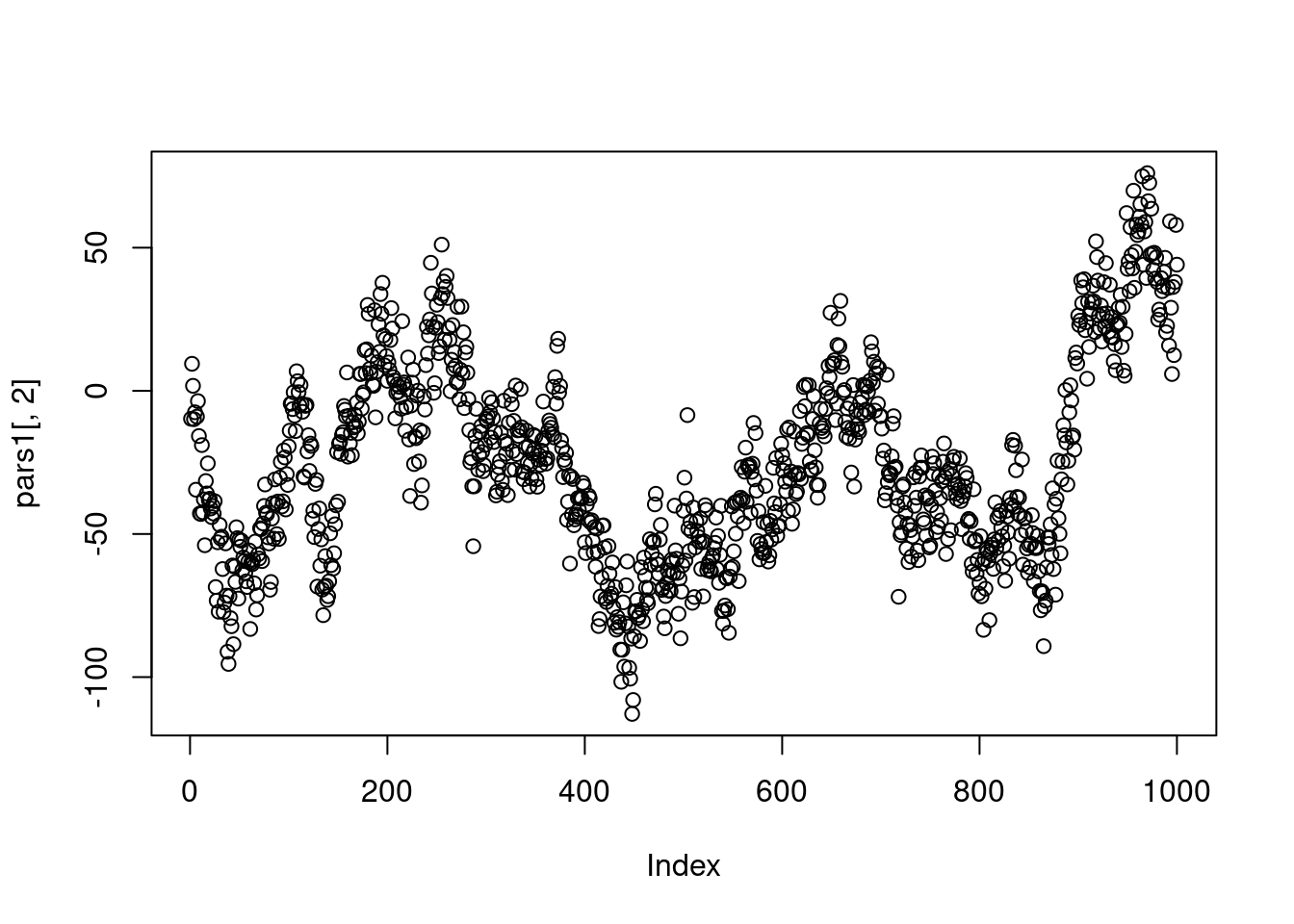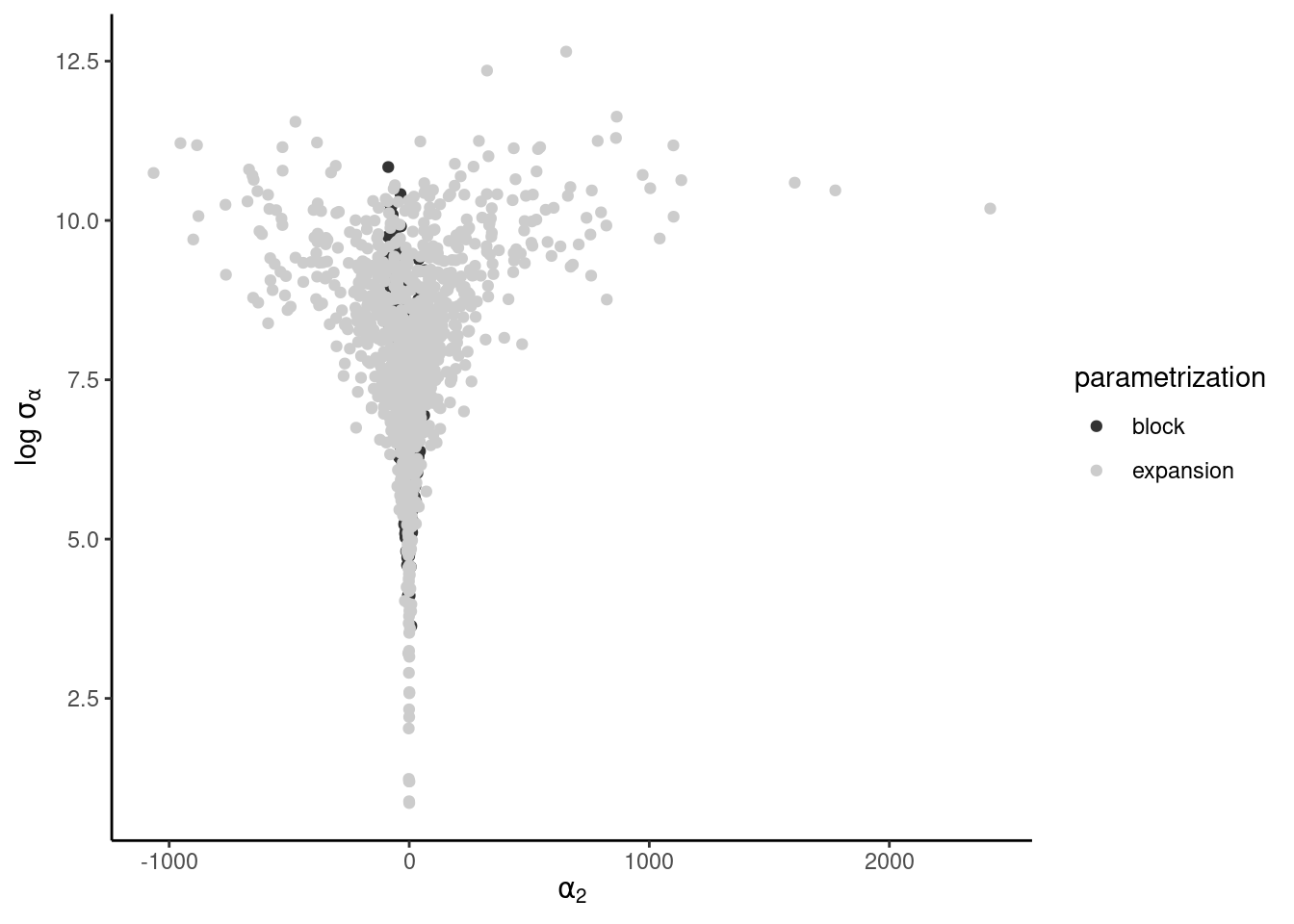
Solution 6
Exercise 6.1
Consider the eight school data from Educational Testing Service (ETS), featured prominently in Gelman et al. (2013). The data shows results of randomized experiments in eight different schools to estimate the effect of coaching on SAT-V scores. The data consist of estimated treatment mean difference and their standard errors. The data size are large, so the average treatment effect (ATE) can be considered Gaussian and the standard errors are treated as a known quantity.
Derive the Gibbs sampler for the two models with improper priors. Note that, to sample jointly from \(p(\mu, \boldsymbol{\alpha} \mid \boldsymbol{y}, \sigma^2_{\alpha}, \boldsymbol{\sigma}^2_{\boldsymbol{y}})\), you can draw from the marginal of \(\boldsymbol{\alpha}\), then the conditional \(\mu \mid \boldsymbol{\alpha}, \cdots\).
Fit the three algorithms described in Gelman et al. (2008) and compare their efficiency via effective sample size (ESS). In particular, draw traceplots and calculate effective sample sizes for
- \(\mu\)
- \(\alpha_1\),
- the sum \(\mu + \alpha_1\).
as well as pairs plot of \(\alpha_i, \log \sigma_{\alpha}\). The latter should display a very strong funnel.
Consider a one-way ANOVA with a single observation per group, where for \(i=1, \ldots, n,\) we have \[\begin{align*} Y_{i} &\sim \mathsf{Gauss}(\mu + \alpha_i, \sigma^2_i) \\ \alpha_i &\sim \mathsf{Gauss}(0, \sigma^2_\alpha) \end{align*}\] and an improper prior for the mean \(p(\mu) \propto 1.\) If there are \(K\) groups, then the group-specific mean is \(\mu+\alpha_k\), and there is a redundant parameter. In the Bayesian setting, the parameters are weakly identifiable because of the prior on \(\boldsymbol{\alpha}\), but the geometry is such that \(\alpha_k \to 0\) as \(\sigma^2_{\alpha} \to 0.\) See Section 5.5 on p. 119 of Gelman et al. (2013) for more details.
We fit the model by adding redundant parameter to improve mixing (Gelman et al., 2008) \[\begin{align*} Y_{i} &\sim \mathsf{Gauss}(\mu + \alpha\xi_i, \sigma^2_i) \\ \xi_i &\sim \mathsf{Gauss}(0, \sigma^2_\xi) \end{align*}\] so that \(\sigma_\alpha = |\alpha|\sigma_\xi.\)
See this post for display of the pathological behaviour that can be captured by divergence in Hamiltonian Monte Carlo.
Solution.
# Eight school data
es <- data.frame(school = LETTERS[1:8],
y = c(28, 8, -3, 7, -1, 1, 18, 12),
se = c(15, 10, 16, 11, 9, 11, 10, 18))
n <- nrow(es)
B <- 1e3L
set.seed(80601)
# Starting values
alpha <- rnorm(0, sd = 0.01)
mu <- mean(es$y)
sigma_al <- sqrt(var(es$y) - mean(es$se))
pars1 <- matrix(NA, nrow = B, ncol = n + 2)
var_mu <- 1/sum(1/es$se^2)
for(b in seq_len(B)){
var_al <- 1/(1/es$se^2 + 1/sigma_al^2)
pars1[b, 1:n] <- alpha <- rnorm(n = n, mean = var_al * (es$y - mu)/es$se^2, sd = sqrt(var_al))
pars1[b, n + 1] <- mu <- rnorm(n = 1, mean = var_mu * sum((es$y - alpha)/es$se^2), sd = sqrt(var_mu))
pars1[b, n + 2] <- sigma_al <- sum(alpha^2) / rchisq(1, df = n - 1)
}
## Sampler 2
# Same model, with joint updates
set.seed(80601)
# Starting values
alpha <- rnorm(0, sd = 0.01)
mu <- mean(es$y)
sigma_al <- sqrt(var(es$y) - mean(es$se))
pars2 <- matrix(NA, nrow = B, ncol = n + 2)
for(b in seq_len(B)){
var_al <- 1/(1/es$se^2 + 1/sigma_al^2)
# Sample from joint of alpha, mu
# by taking p(alpha | sigma_al, y) * p(mu | alpha, sigma_al, y)
pars2[b, 1:n] <- alpha <- rnorm(n = n, mean = var_al * es$y/es$se^2, sd = sqrt(var_al))
pars2[b, n + 1] <- mu <- rnorm(n = 1, mean = var_mu * sum((es$y - alpha)/es$se^2), sd = sqrt(var_mu))
pars2[b, n + 2] <- sigma_al <- sum(alpha^2) / rchisq(1, df = n - 1)
}
# Parameter expansion - V+PX sampler
a <- 1
pars3 <- matrix(NA, nrow = B, ncol = n + 3)
for(b in seq_len(B)){
var_al <- 1/(1/es$se^2 + 1/sigma_al^2)
# Sample from joint of alpha, mu
# by taking p(alpha | sigma_al, y) * p(mu | alpha, sigma_al, y)
alpha_st <- rnorm(n = n, mean = var_al * es$y/es$se^2, sd = sqrt(var_al))
pars3[b, n + 1] <- mu <- rnorm(n = 1, mean = var_mu * sum((es$y - alpha)/es$se^2), sd = sqrt(var_mu))
pars3[b, n + 2] <- sigma_al_st <- sum(alpha_st^2) / rchisq(1, df = n - 1)
pars3[b, n + 3] <- a <- rnorm(n = 1, mean = sum(alpha_st*(es$y-mu)/es$se^2)/sum(alpha_st^2/es$se^2),
sd = sqrt(sum(alpha_st^2/es$se^2)))
pars3[b, 1:n] <- alpha_st*a
pars3[b, n + 2] <- sigma_al <- abs(a)*sigma_al_st
}We can write the joint density of \(\mu\) and \(\boldsymbol{\alpha}\) and integrate out \(\mu\). The precision for \(\alpha_j\) is \(Q_{\alpha_j} = 1/\sigma^2_j + 1/\sigma_{\alpha}^2\), and the unconditional mean of \(p(\alpha_j \mid \sigma_{\alpha})\) is \(Q^{-1}_{\alpha_j}y_j/\sigma^2_j\). The conditional distribution \(p(\mu, \mid \boldsymbol{\alpha}, \sigma_{\alpha})\) is Gaussian with precision \(Q_{\mu} = \sum_{j=1}^{8} \sigma^{-2}_j\) and mean \(Q_{\mu}^{-1}\sum_{j=1}^8 \sigma^{-2}_j(y_j-\alpha_j).\) The other steps are detailed in Gelman et al. (2008).



Exercise 6.2
Let \(Y_{ij1}\) (\(Y_{ij2}\)) denote the score of the home (respectively visitor) team for a soccer match opposing teams \(i\) and \(j\). Maher (1982) suggested modelling the scores as \[\begin{align*} Y_{ij1} \mid \delta, \alpha_i, \beta_j &\sim \mathsf{Poisson}\{\exp(\delta + \alpha_i +\beta_j)\}, \\ Y_{ij2} \mid \delta, \alpha_j, \beta_i &\sim \mathsf{Poisson}\{\exp(\alpha_j+\beta_i)\}, \end{align*}\] where
- \(\alpha_i\) represent the offensive strength of the team,
- \(\beta_j\) the defensive strength of team \(j\) and
- \(\delta\) is the common home advantage.
The scores in a match and between matches are assumed to be conditionally independent of one another given \(\boldsymbol{\alpha}, \boldsymbol{\beta}, \delta\). The data set efl contains the results of football (soccer) matches for the 20232-2024 season of the English Football Ligue (EFL) and contains the following variables
score: number of goals ofteamduring a matchteam: categorical variable giving the name of the team which scored the goalsopponent: categorical variable giving the name of the adversaryhome: binary variable, 1 ifteamis playing at home, 0 otherwise.
- Specify suitable priors for the regression parameters that shrink \(\alpha_i\) and \(\beta_j\) to zero.
- Fit the model:
- Using the posterior distribution, give the expected number of goals for a match between Manchester United (at home) against Liverpool.
- Report and interpret the estimated posterior mean home advantage \(\widehat{\delta}\).
- Calculate the probability that the home advantage \(\delta\) is positive?
- Comment on the adequacy of the fit by using a suitable statistic for the model fit (e.g. the deviance statistic
- Maher also suggested more complex models, including one in which the offensive and defensive strength of each team changed depending on whether they were at home or visiting another team, i.e. \[\begin{align} Y_{ij1} \sim \mathsf{Poisson}\{\exp(\alpha_i +\beta_j + \delta)\}, Y_{ij2} \sim \mathsf{Poisson}\{\exp(\gamma_j+\omega_i)\}, \end{align}\] Does the second model fit significantly better than than the first? Compare the models using WAIC and Bayes factors.
Solution. We use the brms package to generate Stan code following R syntax. Model 1 can be fit by adding random effects for team and opponent. These are assigned penalized complexity priors for the scale such that their 0.99 quantile is 1, giving \(1-\exp(-\lambda_0) = 0.99\) and thus \(\lambda_0=-\log (0.01).\)
library(brms)
data(efl, package = "hecbayes")
# Model 1
fit_brms1 <- brms::brm(formula = score ~ home + (1 | team) + (1 | opponent),
data = efl,
prior = c(
set_prior("normal(0, 10)", class = "b", coef = "home"),
set_prior("exponential(4.605)", class = "sd", group = "team"),
set_prior("exponential(4.605)", class = "sd", group = "opponent")
),
family = poisson,
silent = 2,
open_progress = FALSE,
refresh = 0,
save_model = "Maher1.stan",
seed = 1)
summary(fit_brms1) Family: poisson
Links: mu = log
Formula: score ~ home + (1 | team) + (1 | opponent)
Data: efl (Number of observations: 760)
Draws: 4 chains, each with iter = 2000; warmup = 1000; thin = 1;
total post-warmup draws = 4000
Multilevel Hyperparameters:
~opponent (Number of levels: 20)
Estimate Est.Error l-95% CI u-95% CI Rhat Bulk_ESS Tail_ESS
sd(Intercept) 0.24 0.05 0.15 0.36 1.00 1581 2354
~team (Number of levels: 20)
Estimate Est.Error l-95% CI u-95% CI Rhat Bulk_ESS Tail_ESS
sd(Intercept) 0.25 0.05 0.16 0.38 1.00 1280 2344
Regression Coefficients:
Estimate Est.Error l-95% CI u-95% CI Rhat Bulk_ESS Tail_ESS
Intercept 0.34 0.09 0.15 0.51 1.00 1624 2430
home 0.20 0.06 0.09 0.31 1.00 7522 2961
Draws were sampled using sampling(NUTS). For each parameter, Bulk_ESS
and Tail_ESS are effective sample size measures, and Rhat is the potential
scale reduction factor on split chains (at convergence, Rhat = 1).# Use S3 generic for prediction, with new data frame
predict(fit_brms1, newdata = data.frame(home = 1, team = "Man Utd", opponent = "Liverpool")) Estimate Est.Error Q2.5 Q97.5
[1,] 1.25875 1.139352 0 4# Manual prediction from posterior predictive
# 1) extract simulations
sims <- fit_brms1$fit@sim$samples[[1]]
nsim <- length(sims[[1]])
# 2) calculate the posterior mean for the match for each team (Poisson with log link)
post_mean1 <- exp(sims$b_Intercept + sims$b_home + sims$`r_opponent[Liverpool,Intercept]` + sims$`r_team[Man.Utd,Intercept]`)
post_mean2 <- exp(sims$b_Intercept + sims$`r_team[Liverpool,Intercept]` + sims$`r_opponent[Man.Utd,Intercept]`)
# 3) generate the number of goals from the posterior predictive
post_pred1 <- rpois(n = nsim, lambda = post_mean1)
post_pred2 <- rpois(n = nsim, lambda = post_mean2)
# Plot the posterior predictive (bar plot)
g1 <- ggplot(data = data.frame(x = c(post_pred1, post_pred2),
team = rep(c("Manchester United", "Liverpool"), each = nsim)),
aes(x = x, fill = team)) +
geom_bar(position = position_dodge()) +
labs(x = "number of goals")
g2 <- ggplot(data = data.frame(delta = exp(sims$b_home)),
mapping = aes(x = delta)) +
geom_density() +
labs(x = expression("home advantage"~exp(delta)))
g1 + g2
# Model 2
fit_brms2 <- brms::brm(formula = score ~ home + (1 | team) + (1 | opponent),
data = efl,
prior = c(
set_prior("normal(0, 10)", class = "b", coef = "home"),
set_prior("exponential(4.605)", class = "sd", group = "team"),
set_prior("exponential(4.605)", class = "sd", group = "opponent")
),
family = poisson,
save_model = "Maher2.stan",
silent = 2,
open_progress = FALSE,
refresh = 0)
summary(fit_brms2) Family: poisson
Links: mu = log
Formula: score ~ home + (1 | team) + (1 | opponent)
Data: efl (Number of observations: 760)
Draws: 4 chains, each with iter = 2000; warmup = 1000; thin = 1;
total post-warmup draws = 4000
Multilevel Hyperparameters:
~opponent (Number of levels: 20)
Estimate Est.Error l-95% CI u-95% CI Rhat Bulk_ESS Tail_ESS
sd(Intercept) 0.24 0.05 0.15 0.36 1.00 1494 2626
~team (Number of levels: 20)
Estimate Est.Error l-95% CI u-95% CI Rhat Bulk_ESS Tail_ESS
sd(Intercept) 0.25 0.05 0.16 0.37 1.00 1731 2403
Regression Coefficients:
Estimate Est.Error l-95% CI u-95% CI Rhat Bulk_ESS Tail_ESS
Intercept 0.34 0.09 0.16 0.52 1.00 1672 2242
home 0.20 0.06 0.09 0.31 1.00 9488 2716
Draws were sampled using sampling(NUTS). For each parameter, Bulk_ESS
and Tail_ESS are effective sample size measures, and Rhat is the potential
scale reduction factor on split chains (at convergence, Rhat = 1).waic(fit_brms1); waic(fit_brms2)
Computed from 4000 by 760 log-likelihood matrix.
Estimate SE
elpd_waic -1170.7 16.4
p_waic 27.8 1.5
waic 2341.5 32.9
2 (0.3%) p_waic estimates greater than 0.4. We recommend trying loo instead.
Computed from 4000 by 760 log-likelihood matrix.
Estimate SE
elpd_waic -1170.7 16.4
p_waic 27.7 1.5
waic 2341.4 32.9
2 (0.3%) p_waic estimates greater than 0.4. We recommend trying loo instead. We can also fit the model using integrated nested Laplace approximations.
library(INLA)
# Default prior for random effects
# inla.models()$latent$iid$hyper$theta
prec_prior <- list(theta = list(prior = "pc.prec", param = c(1, 0.01)))
fit_inla <- INLA::inla(
score ~ home + f(team, model = "iid", hyper = prec_prior) +
f(opponent, model = "iid", hyper = prec_prior),
family = "poisson",
data = efl)
marg_delta <- fit_inla$marginals.fixed[[2]]
inla.pmarginal(q = 0, marginal = inla.smarginal(marg_delta))[1] 0.0002693049ggplot(data = data.frame(inla.smarginal(marg_delta)), mapping = aes(x = x, y = y)) +
geom_line() +
labs(x = expression(delta), y = "", subtitle = "Marginal density of home advantage") +
theme_classic()